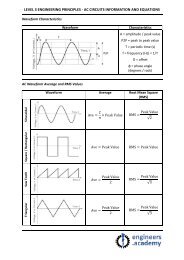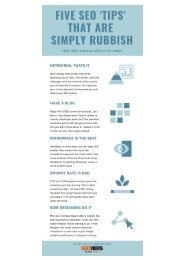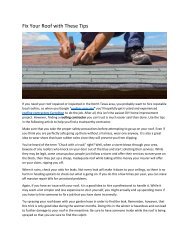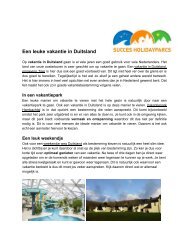Max Velocity Sprinting
http://www.kgelite.ie/ This article will review KG Elite Performance’s maximal velocity sprint mechanics with particular focus on the primary factors affecting performance, and the characteristics required to optimise max velocity sprinting mechanics.
http://www.kgelite.ie/
This article will review KG Elite Performance’s maximal velocity sprint mechanics with particular focus on the primary factors affecting performance, and the characteristics required to optimise max velocity sprinting mechanics.
You also want an ePaper? Increase the reach of your titles
YUMPU automatically turns print PDFs into web optimized ePapers that Google loves.
displacement of the athlete’s body during mid swing phase causing greater stride length. The second<br />
benefit of increased force application is not so obvious and is often misunderstood. This benefit is<br />
that of increased stride frequency. Therein lies the question, how can increased stride frequency be<br />
caused by increased force application to the ground? Let’s try to simplify things to explain further.<br />
Stride frequency is comprised of two components: ground contact time and flight time. Research on<br />
elite sprinters indicates that the best sprinters spend less time on the ground (Mann, 1986; 2005;<br />
Mann & Herman, 1985). This is because the forces they produce are so great that they enter a<br />
period of flight more rapidly than weaker and slower sprinters. As a result, despite not moving their<br />
limbs significantly faster through the air (Weyand et al., 2000), faster and more skilled sprinters tend<br />
to have greater stride frequency because they reduce the amount of time they spend on the<br />
ground. As a result of an accumulation of research from Mann and Weyand, we now know that<br />
stride length and stride rate are related to max velocity speed performance but are not the primary<br />
causative factors associated with performance.<br />
Force Application & <strong>Sprinting</strong> Speed<br />
If you ask all the successful sprint coaches and biomechanists such as Charlie Francis, Tom Tellez,<br />
Loren Seagrave, Ralph Mann and Peter Weyand, they will all contend that force production and<br />
application is critically important for sprinting performance. Essentially an athlete must increase the<br />
force they apply to the ground and do so over increasingly shorter periods of time. Just as important<br />
as the magnitude of force application however, is the direction of that force application. For<br />
instance, during acceleration athletes attempt to apply large horizontal forces to facilitate braking<br />
inertia and maximising speed off the mark. This results in a large forward lean (45°-60° subject to<br />
sprinting on track or pitch).<br />
During max velocity sprinting, athletes should attempt to minimise braking forces and increase<br />
vertical propulsive forces. Vertical propulsive forces are important because once momentum has<br />
been maximally developed during the acceleration period, the body will tend to keep moving<br />
forward at the same speed as long as the internal and external forces acting on the body are<br />
balanced. With more vertical force generation, more time will be spent in the air which will allow the<br />
athlete to reposition their limbs more effectively for the next ground contact.<br />
With these fundamental concepts in mind, what can coaches do to maximise max velocity sprint<br />
performance? From my perspective and all the tutors at Elite Performance Institute (EPI), we focus<br />
on three primary areas:<br />
1. Develop the force-velocity curve<br />
2. Focus on direction of force application<br />
3. Optimise sprinting mechanics<br />
We assess all aspects of the the athlete’s FV curve to identify any limitations. For max velocity<br />
sprinting, these can include speed-strength and fast stretch shortening cycle (SSC) qualities. We then<br />
prioritise vertical force production exercises for both the FV curve development as well as speed<br />
mechanics.

















